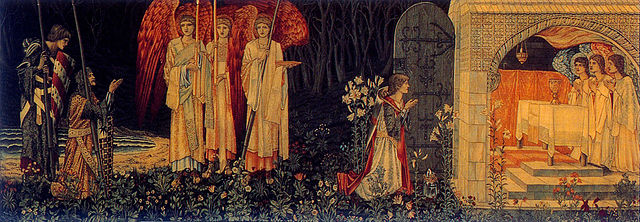Edwin Austin Abbey was an American muralist, illustrator, and painter. He flourished at the beginning of what is now referred to as the "golden age" of illustration, and is best known for his drawings and paintings of Shakespearean and Victorian subjects, as well as for his painting of Edward VII's coronation. His most famous set of murals, The Quest and Achievement of the Holy Grail, adorns the Boston Public Library.
Edwin Austin Abbey, ca. 1900
Edwin Austin Abbey (1888), by John Singer Sargent, Yale University Art Gallery.
King Lear, Act I, Scene I (1897-98), Metropolitan Museum of Art.
Lunette and medallion murals (1908-11), Pennsylvania State Capitol Rotunda. Left to right: The Spirit of Vulcan, Science, The Spirit of Religious Liberty, Art, The Spirit of Light.
The Holy Grail is a treasure that serves as an important motif in Arthurian literature. Various traditions describe the Holy Grail as a cup, dish, or stone with miraculous healing powers, sometimes providing eternal youth or sustenance in infinite abundance, often guarded in the custody of the Fisher King and located in the hidden Grail castle. By analogy, any elusive object or goal of great significance may be perceived as a "holy grail" by those seeking such.
The Damsel of the Sanct Grael by Dante Gabriel Rossetti (1874)
Galahad, Bors and Percival achieve the Grail. Tapestry woven by Morris & Co. (19th century)
Sir Galahad, the Quest for the Holy Grail by Arthur Hughes (1870)
The Holy Grail depicted on a stained glass window at Quimper Cathedral








